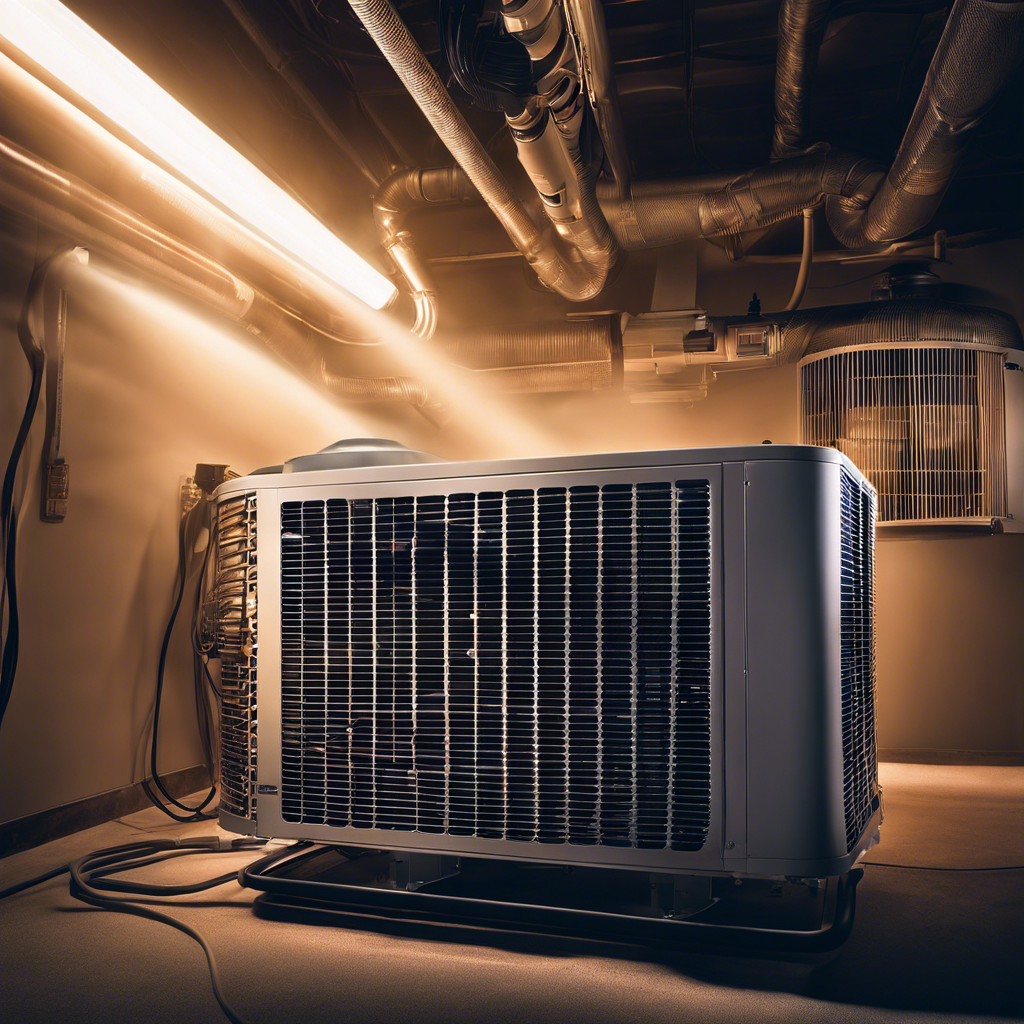Installing UV lights in HVAC systems is a highly effective method for enhancing indoor air quality. These lights play a crucial role in eliminating harmful mold and bacteria, resulting in a healthier environment for everyone, particularly those who suffer from allergies and respiratory conditions.
Moreover, UV lights contribute to the overall efficiency of HVAC units, reducing potential damage and leading to long-term cost savings.
However, it is important to note that while UV lights are effective in eliminating certain contaminants, they do not remove dust and dander from air circulation. Hence, for optimal results, it is recommended to combine the installation of UV lights with other measures such as proper ventilation and air filtration.
In this way, individuals can create a space that fosters a sense of belonging and promotes wellbeing.
Key Takeaways
- UV lights in HVAC systems enhance indoor air quality by eliminating harmful mold and bacteria.
- UV lights contribute to the overall efficiency of HVAC units, leading to cost savings.
- UV lights create a healthier environment for individuals with allergies and respiratory conditions.
- UV lights should be installed when addressing indoor air quality issues related to bacteria, viruses, and pathogens.
Benefits of UV Lights in HVAC Systems
The installation of UV lights in HVAC systems offers numerous benefits for improved air quality. UV lights have the ability to sanitize the air by destroying harmful bacteria and mold, thus limiting mold growth in the HVAC system and preventing respiratory illnesses. This not only improves the overall air quality but also contributes to the creation of a healthier indoor environment for occupants.
Additionally, UV lights can effectively destroy volatile organic compounds (VOCs) that cause unpleasant odors, further enhancing the quality of the air. By sterilizing the evaporator coil and drain pan, UV lights reduce the accumulation of harmful microbes and improve the condition of mechanical components. The result is cleaner air conditioning and improved performance of the air handler.
UV lights in HVAC systems are an effective method for air purification and can significantly reduce the presence of mold spores and other airborne contaminants. Incorporating UV lights into HVAC systems ensures higher levels of air sanitization, providing occupants with a healthier and more comfortable living or working environment.
Types of UV Lights for HVAC Systems
There are various types of UV lights available for HVAC systems that can improve air quality. One type is coil sterilization lights, which are installed inside the return air ducts. These lights range in price from $60 to $280, excluding installation costs.
Another type is air sterilization lights, which are hardwired into the air ducts. The unit itself can cost between $80 and $400. UVC germicidal bulbs are also used in HVAC systems for air disinfection. These bulbs emit UVC radiation at 254 nm, which is highly effective at eradicating microorganisms.
Additionally, upper-room Ultraviolet Germicidal Irradiation (UVGI) systems are used to kill airborne pathogens and improve indoor air quality. It is important to note that while UVGI provides effective sterilization, it should be used in conjunction with air filtration and does not replace the need for HEPA filtration.
Pros and Cons of Installing HVAC UV Lights
While there are advantages and disadvantages to installing UV lights in HVAC systems, it is important to consider the potential benefits and drawbacks.
One of the main pros of installing UV lights is the improved air quality. UV lights can effectively kill bacteria, viruses, and other pathogens present in the air, thus reducing the risk of diseases and allergies. Additionally, by purifying the air, UV lights contribute to a healthier indoor environment.
Another advantage is the potential cost savings. HVAC UV lights can help improve the efficiency of the system, leading to reduced heating or air conditioning costs.
However, there are also cons to consider. UV lights do not eliminate dust and dander, which are common allergens. Installation costs and bulb replacements can be expensive, and regular cleaning is necessary.
Despite these drawbacks, the benefits of installing UV lights in HVAC systems for improved air quality cannot be ignored.
When to Install UV Lights in HVAC Systems
UV lights should be installed in HVAC systems when addressing issues related to indoor air quality, such as the presence of bacteria, viruses, and other pathogens. By installing UV lights in HVAC systems, improved air quality can be achieved through air sterilization and coil sanitizing.
Installing HVAC UV lights provides a proactive approach to reducing the spread of airborne viruses and improving overall cleanliness. UV lights for HVAC systems are particularly beneficial for those with allergies and respiratory issues, as they help remove bacteria, germs, and mold from the air while the system is in use.
Additionally, installing UV lights enhances the efficiency of HVAC units and reduces damage caused by contaminants. Therefore, considering an UV light system for HVAC installation is an effective strategy for improving indoor air quality and creating a healthier environment.
Cost of Installing UV Lights in HVAC Systems
The cost of installing UV lights in HVAC systems can range from $200 to $700, depending on the type of light. Coil sterilization lights typically cost between $60 and $280, excluding installation, while air sterilization lights range from $80 to $400 for the unit itself. These initial costs cover the purchase and installation of the UV lights.
Additionally, replacement UV light bulbs can cost between $10 and $75.
It is also important to consider the impact on monthly energy bills, as running UV lights can increase costs by approximately $15 to $30.
Despite the upfront and ongoing expenses, the installation of UV lights in HVAC systems is a worthwhile investment for improved air quality.
Frequently Asked Questions
Do UV Lights Improve Air Quality?
UV lights effectively improve air quality by eliminating bacteria, germs, and viruses, reducing the spread of airborne illnesses. They also prevent mold growth and enhance HVAC energy efficiency. Proper installation and maintenance are essential for optimal performance.
Where Is the Best Place to Install a UV Light in Hvac?
The optimal positioning for UV lights in HVAC systems depends on various factors including UV light effectiveness, compatibility with the HVAC system, maintenance requirements, energy efficiency considerations, lifespan, installation process, impact on indoor air pollutants, safety precautions, and benefits for allergy sufferers.
How Much Does It Cost to Install UV Light in Residential Hvac?
The cost of installing UV lights in residential HVAC systems can range from $200 to $700, depending on the type of light. UV lights improve air quality, require regular maintenance, and may increase energy consumption. Professional installation is recommended for safety.
Does UV Light Clean Air Ducts?
UV lights are not designed to clean air ducts. However, they can help sterilize the air passing through the HVAC system by killing mold spores and reducing indoor allergens. Regular maintenance, safety precautions, and energy consumption should be considered.
Conclusion
In conclusion, the installation of UV lights in HVAC systems offers numerous benefits for improving indoor air quality.
These lights effectively eliminate mold and bacteria, creating a healthier environment for individuals with allergies and respiratory issues.
Additionally, UV lights enhance the efficiency of HVAC units while reducing damage, resulting in long-term cost savings.
However, it is important to note that UV lights alone do not remove dust and dander from air circulation, necessitating the implementation of other measures such as proper ventilation and air filtration for optimal results.


